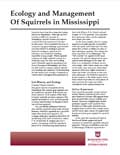Game Animals
Non-game Animals
Habitat
Eastern Gray Squirrel & Fox Squirrel
Sciurus carolinensis and Sciurus niger
- Very common, tree-dwelling rodents
- Found in urban and suburban environments, parks, and forests
- Require a variety of food for nutrients
Species Description: Eastern Gray Squirrel and Fox Squirrel
There are two types of tree squirrels found in Mississippi: the eastern gray squirrel and the eastern fox squirrel. Both of these squirrels are found throughout the state with gray squirrel populations being higher.
They inhabit both hardwood and coniferous forests. Mature, hardwood and mixed pine-hardwood forests and longleaf pine forests offer ideal habitats. Squirrels build nests from leaves and twigs about 25 feet or more from the ground. They also burrow in hollow trees and tree cavities. Squirrels survive on mast (acorns, nuts, seeds and fruit) and pine seed. They also feed on fungi, insects and grubs.
Squirrels live about 18 months and have fairly high death rates. The population remains stable when quality habitat and food is available. The amount of food available is variable depending on weather and availability of forested land. Main causes of death are predators (domestic cats, hawks, owls, bobcats and snakes), inclement weather, disease and car accidents.

Ecology and Management of Squirrels in Mississippi (PDF)
Mississippi State University Extension Service
This publication provides a history and physical description of the gray squirrel and fox squirrel, along with how to distinguish between the two. It gives a description of the tree squirrel’s mating habits, parasites, diseases and predators. A list of trees and their food values is given, as well as a list of recommended timber management practices that can be used to help the squirrel population. Conservation programs that can be used for squirrel management are also listed in detail.
Wildlife Damage Control: Tree Squirrels (PDF)
Penn State College of Agricultural Sciences
Squirrels may damage houses or structures by chewing on wood, insulation, or wiring. They also make nests in attics or other areas. The best way to avoid damage is to prevent squirrels from entering a building or structure. Metal collars or baffles on poles and trees near homes can keep squirrels from climbing them. Blocking openings with mesh or repairs will help. Live trap squirrels inside a building to remove them.
Eastern Gray Squirrel: Squirrel Boxes and Seasonal Foods (PDF)
N.C. Cooperative Extension
Many game and nongame species benefit from management activities for gray squirrels. Tips for improving squirrel habitat including seasonal foods and the construction of nest boxes are given.
Standing dead trees are called snags. They often have cavities or holes in them that provide nesting habitat and homes for birds, food and homes for woodpeckers, homes for salamanders and frogs and a multitude of insects.

